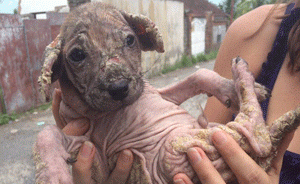








Parvo in dogs is a real tragedy. Once the virus chooses his victim, most dogs will suffer a great deal of pain and anguish. The virus strikes quickly in stealth; both you and your dog will not what know hit him.
One day he looks fine, and in the blink of an eye, he’s lethargic, depressed, refuses to eat or drink any liquids, he will be dehydrated because of uncontrolled vomiting along with extremely foul-smelling diarrhea that is often bloody, he may also have a fever, or chills, and will sleep an unusual amount of hours (day and night), as these are the main signs of Parvo to look out for.
Why is Parvo so devastating?
The incubation period of the virus is anywhere from 3 – 15 days. This is no hibernation period; this is a recruitment/growth period. The virus is looking for ways to become invincible. So, during this seemingly quiet time, he is gathering troops and cloning himself through rapid cell division, thus stacking the deck in his favor.
Now, all of this activity requires fuel (remember everything has a cost), so where does that come from?
The host (in this case, your beloved pet).
Parvo is going after easy food sources (such as your dog’s bone marrow, and then he’s off to shred your dog’s intestines), after all, that is one of the things he does best – find easy targets.
What is the profile of a typical host that Parvo seeks out?
He goes after animals that are weak and have vulnerabilities that he can easily exploit. Here are a few scenarios that the Parvo virus would readily seek out:
Young immature puppies with underdeveloped immune systems.
Sickly dogs that have low immune systems, perhaps from excessive chemicals from canine vaccines, de-wormers, commercial (i.e. poor-quality) pet food that is
nutritionally bankrupt (see our recommended dog food site for more info on this topic), chemicals in the environment, and so forth.
Older dogs that may have chronic problems and have been subjected to excessive chemicals.
Dogs that have had a major illness and are recovering.
Dogs that have parasites.
In all of the above cases, the animals have weakened immune systems for various reasons, and they become easy victims for Parvo.
Parvovirus Symptoms:
Lethargy and a lack of playfulness.
Not eating or drinking.
Vomit (often starting as an off-white mucus, turning later on to a yellow frothy vomit).
Diarrhea (normally foul-smelling and frequently bloody).
Dehydration.
Fever.
Chills.
Depression

Kennel cough is a syndrome affecting canines.[1] Characterized as inflammation of the upper respiratory system, it can be caused by viral infections, such as canine distemper, canine adenovirus, canine parainfluenza virus, canine respiratory coronavirus or Orthomyxoviridae Influenzavirus, or bacterial infections, such as Bordetella bronchiseptica.[2] It is so named because the infection can spread quickly among dogs, such as in the close quarters of a kennel.
Both virus and bacterial causes of kennel cough are spread through the air by infected dogs sneezing and coughing. It can also spread through contact with contaminated surfaces and through direct contact. It is highly contagious, even days or weeks after symptoms disappear. Symptoms begin usually two to three days after exposure,[2] and can progress to pneumonia. From recent studies, kennel cough is now believed to be a zoonotic disease, meaning it can transfer from animal to human and vice versa.
Symptoms
Symptoms can include a harsh, dry cough, retching, sneezing, snorting, gagging or vomiting in response to light pressing of the trachea or after excitement or exercise. The presence of a fever varies from case to case. The disease can last initially from 10–20 days and can rebreak when the dog is put into a stressful situation which puts stress on the dog’s immune system. Diagnosis is made by seeing these symptoms; having a history of exposure is also helpful, but not always found, as kennel cough is easily spread through contact with contaminated surfaces, such as the ground, toys, and sidewalks.
Treatment and prevention
Antibiotics are given to treat any bacterial infection present. Cough suppressants are used if the cough is not productive. Prevention is by vaccinating for canine adenovirus, distemper, parainfluenza, and Bordetella. In kennels, the best prevention is to keep all the cages disinfected. In some cases, such as Doggie Daycares or Non-Traditional Playcare type boarding environments, it is usually not a cleaning or disinfecting issue, but rather an airborne issue, as the dogs are in contact with each other’s saliva and breath. Although most kennels require proof of vaccination, the vaccination is not a fail-safe preventative. Just like human influenza, even after receiving the vaccination, a dog can still contract mutated strains or less severe cases. When dogs have kennel cough they should not be ran or walked very far to prevent it from coming back.

Dog mange is a skin condition that creates severe pain and itching for dogs. Along with the discomfort, mange can also lead to scaling and scabbing that can become infected. The root cause of dog mange is the presence of mites that burrow into the skin and cause the body to attempt to expel the invaders and relieve the itching and general discomfort.
While mange is normally associated only with dogs, it is also possible for the condition to be passed on to other mammals as well. This is partly due to the fact that pus may drain from the exposed skin of a dog suffering with mange. Tiny mites may be found in the pus and be passed on to a new host. When this occurs, the mites burrow into the skin of the new host, leading to the loss of hair and reddish scales on the exposed skin.
Along with the loss of hair and the development of the red hue on the surface of the skin, dog mange also can cause the development of pimples in the infected area. Dry patches of skin may also develop, eventually becoming thicker in texture than the surrounding areas. The dog will also often develop scaling around the mouth, eyes, and the front legs as the condition continues to worsen.
The type of mite that has invaded the skin often determines the exact course of treatment for dog mange. Sarcopticthe mites are round shaped while demodectic mites are elongated and have an appearance that is somewhat like that of a cigar. In both cases, the mites move around under the surface of the skin and create an itching sensation that is almost unbearable for the host.
In minor cases, dogs may be able to scratch and dislodge the mites before they become too settled into the skin. When this happens, the mange normally clears up in a few weeks. However, it is usually a good idea to take the animal to a veterinarian and initiate treatments immediately. Treatments may include the administration of medications to kill the mites from within the body or shampoos and body washes that treat the skin from the outside and eventually kill any mites still present.
Use only medicated shampoos recommended by the veterinarian, as these will not harm the dog, but will begin to heal the skin while still killing the mites. We also administer Divectilack via needle and in food to quickly erridicate the mite and relive the dogs of the pain.

Distemper Canine distemper is very common in Bali due to only a small amount of dogs receiving complete vaccinations.
The virus has almost been eliminated in many western countries due to successful vaccination campaigns.
We recommend 2 complete vaccines as a puppy and boosters every year to ensure the dog has immunity to the virus.
Distemper is a highly contagious virus which affects many of the body’s major organs. The virus does not live long off the infected dog, but is usually transmitted by close contact & through the air when a dog coughs. The virus replications within the dog & they can still be shedding the disease months after infection. The virus infects the respiratory tract, gastrointestinal tract and nervous system.
The most common symptoms seen are coughing, fever, diarrhea, hardening of the foot pads, nasal and/or eye discharge, twitches, seizures. Symptoms can vary greatly from case to case. Some dogs may have all the symptoms, where as other will only have 1 symptom or only have symptoms in the last stages of the disease. If a puppy has only had 1 vaccine, it may still have distemper, but the symptoms have been masked by the disease. Make sure to have 2 complete vaccines to protect your dog. Some dogs do survive the disease but are left with a permanent twitch. As the symptoms are common to other common disease, diagnosis & treatment need to be done by a veterinary professional.
It is spread primarily through the air from respiratory discharges but can also be transmitted through other bodily secretions. Distemper is a highly contagious disease of dogs as well as other animals such as cats, horses, skunks, foxes, wolves and raccoons. In canines, this disease chiefly affects young dogs between the ages of 3 months to 4 years old and is often fatal.
Any young dog with any signs of illness should be taken to a veterinarian as soon as possible

There are a number of different worms that can affect your dog: roundworms, tapeworms, hookworms, whipworms and heartworms. Some live in the intestines and some in the tissue. Many worms do not pose a problem for your dog at all, and you will not even be aware that they are even there. Some worms can be tolerated in small numbers, but in high numbers can create serious problems.
Generally a dog should be treated every six months for roundworms and tapeworms. They are the most common, with roundworm being the bigger problem.
Puppies should be treated at 4, 6, 8, 10, 12, 14 and 16 weeks regularly, about every two weeks up to the puppy reaching three months old and again as advised by your vet, and with vet recommended medicine. Be sure to deworm the dam. Talk to your vet.
Tapeworms and roundworms can infect people.
In all areas where there are dogs, there are roundworm eggs.
Roundworms: (Toxocara canis)
Roundworms, also called ascarids, are of whitish color. They look just like a piece of cooked spaghetti, and live in your dog’s intestine. They can reach up to eight inches in length (20cm) and feed off of your dog’s food, in the intestine. Roundworms shed eggs continually. You can either treat your dog for roundworms every six months, OR you can have it tested and only treat if your dog has them.
Roundworms migrate throughout the blood into the lungs, are coughed up, and usually re-swallowed. Sometimes the larvae can travel through the liver and brain.
You may never see these worms, and one day one may come out in the dog’s stool. They can cause bloating, diarrhea and vomiting. Your dog may stop eating, after passing a stage of overeating, and always being hungry.
In young puppies untreated roundworms can cause the bowel to rupture. Puppies get roundworms from their mom, as the larval worms migrate into the womb, or into her teats. A pregnant dam can be treated for roundworms, and should be. Ask your vet. Dogs should be discouraged from pooping where kids play, as roundworms are especially dangerous to children. Roundworm eggs can lie dormant in a sandbox for years. Once they enter the child host they can migrate to the child’s liver, lungs, eyes or brain and become permanently encysted.
Tapeworms (Taenia and dipylidium species)
Tapeworms look like a piece of rice on the stool but not in it, or sometimes can be seen sticking like little white eggs to the dog’s anus.
There are a few different varieties of tapeworms. Fleas carry tapeworms, so if your dog has fleas, or had fleas, there is a good chance he could have tapeworms (see flea write-up). Also if the dog eats the flea he could have tapeworms.
Standard wormer doesn’t always kill tapeworms, so a stronger wormer is needed.
Many vets recommend worming for tapeworm and roundworms every 6-12 months.
You cannot treat a pregnant or nursing dam, or puppies for tapeworm.
Like roundworms, people can also get tapeworms. People can get tapeworms from ingesting a flea from a dog, which is not hard; considering a flea is so small, it could easily land on your plate, or your hand, and be ingested unnoticed. A tapeworm is not that dangerous to a dog, it is referred to by some as the smart parasite, but it can be dangerous to people, causing serious liver disease.
The tapeworm actually consists of many white segments, joined together like a tape. They tape together and can get to be several feet long. Then they drop off to multiply. It is the segments that are seen as they shed. These segments contain the eggs which look like wiggling grains of rice.
Hookworm (Ancylostoma coaninum)
Looks like roundworm, but has teeth at one end that grab onto the dog’s intestine and attaches itself. It changes the attachment site at least six times per day. There is blood loss to feed the bloodsucking worms, but most blood is lost at the spots of detachment until they heal, thus causing anemia and iron-deficiency. Hookworms and whipworms are bloodsuckers. These can make a puppy anemic.
Heartworms (Uncinara)
Heartworms live in the heart and large blood vessels. They are about six inches long. They are spread by mosquitoes. The tree-hole mosquito, which breeds in oak trees, is very good at spreading heartworms. They live in areas where oak trees thrive. If you have oak trees in your area, you most likely live in an area where there are heartworms. Heartworms show no symptoms at all until the disease is very advanced. When symptoms do appear they are the same as the symptoms for congestive heart failure—sometimes causing fainting, coughing, difficulty breathing, dull coat, lack of energy, and an enlarged abdomen. Heartworms can be prevented. Dogs should be tested for heartworms, then given a preventive medicine. It is not wise to wait until symptoms appear before treating this dangerous worm. Talk to your vet.
All dogs at some time in their lives have worms, but with modern treatments, they are easily eliminated, and harmless to your pet. IF ALL dogs were regularly treated for worms, the risk to human health could be reduced greatly.
Whipworms (Trichuris)
Are not visible to the naked eye. Vet diagnosis only

Rabies is a severe, and often fatal, viral polioencephalitis that specifically affects the gray matter of the dog’s brain and its central nervous system (CNS). The primary way the rabies virus is transmitted to dogs is through a bite from a disease carrier: other dogs, mokeys, bats etc. Infectious virus particles are retained in a rabid animal’s salivary glands to better disseminate the virus through their saliva.
Once the virus enters the dog’s body, it replicates in the cells of the muscles, and then spreads to the closest nerve fibers, including all peripheral, sensory and motor nerves, traveling from there to the CNS via fluid within the nerves. The virus can take up to a month to develop, but once the symptoms have begun, the virus progresses rapidly.
This inflammatory infection also has zoonotic characteristics and can therefore be transmitted to humans.
Symptoms and Types of Rabies in Dogs
There are two forms of rabies: paralytic and furious. In the early symptom (prodomal) stage of rabies infection, the dog will show only mild signs of CNS abnormalities. This stage will last from one to three days. Most dogs will then progress to either the furious stage, the paralytic stage, or a combination of the two, while others succumb to the infection without displaying any major symptoms.
Furious rabies is characterized by extreme behavioral changes, including overt aggression and attack behavior. Paralytic rabies, also referred to as dumb rabies, is characterized by weakness and loss of coordination, followed by paralysis.
This is a fast-moving virus. If it is not treated soon after the symptoms have begun, the prognosis is poor.
The following are some of the symptoms of rabies to watch for in your dog:
Causes of Canine Rabies
The rabies virus is a single-stranded RNA virus of the genus Lyssavirus, in the familyRhabdoviridae. It is transmitted through the exchange of blood or saliva from an infected animal, and very rarely through breathing in the escaping gasses from decomposing animal carcasses. Contracting the virus in this way is rare but it can occur, often in caves with large populations of bats, where the virus is widespread.
Diagnosing Rabies in Dogs
Rabies can be confused with other conditions that cause aggressive behavior, so a laboratory blood analysis must be conducted to confirm the presence of the virus. However, blood testing for the virus is not veterinary procedure.
Price Based Country test mode enabled for testing Indonesia. You should do tests on private browsing mode. Browse in private with Firefox, Chrome and Safari